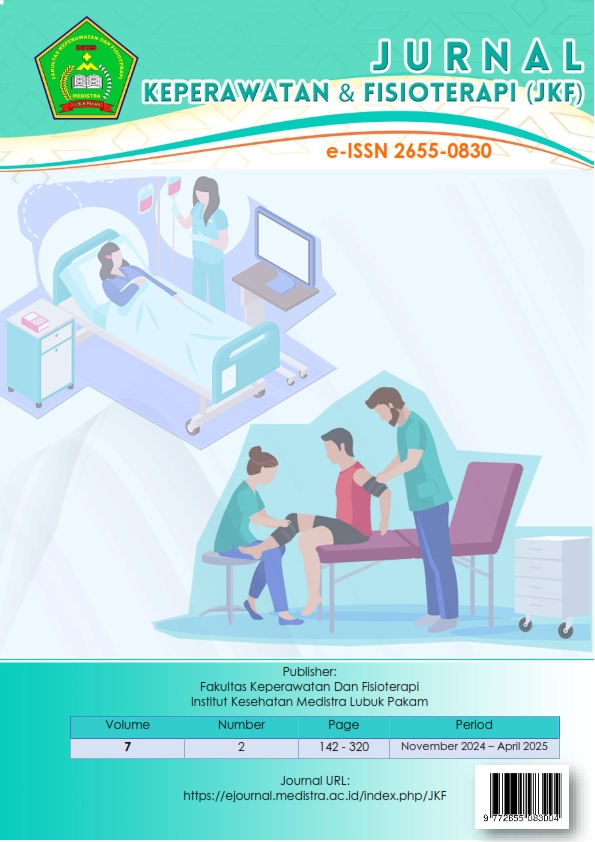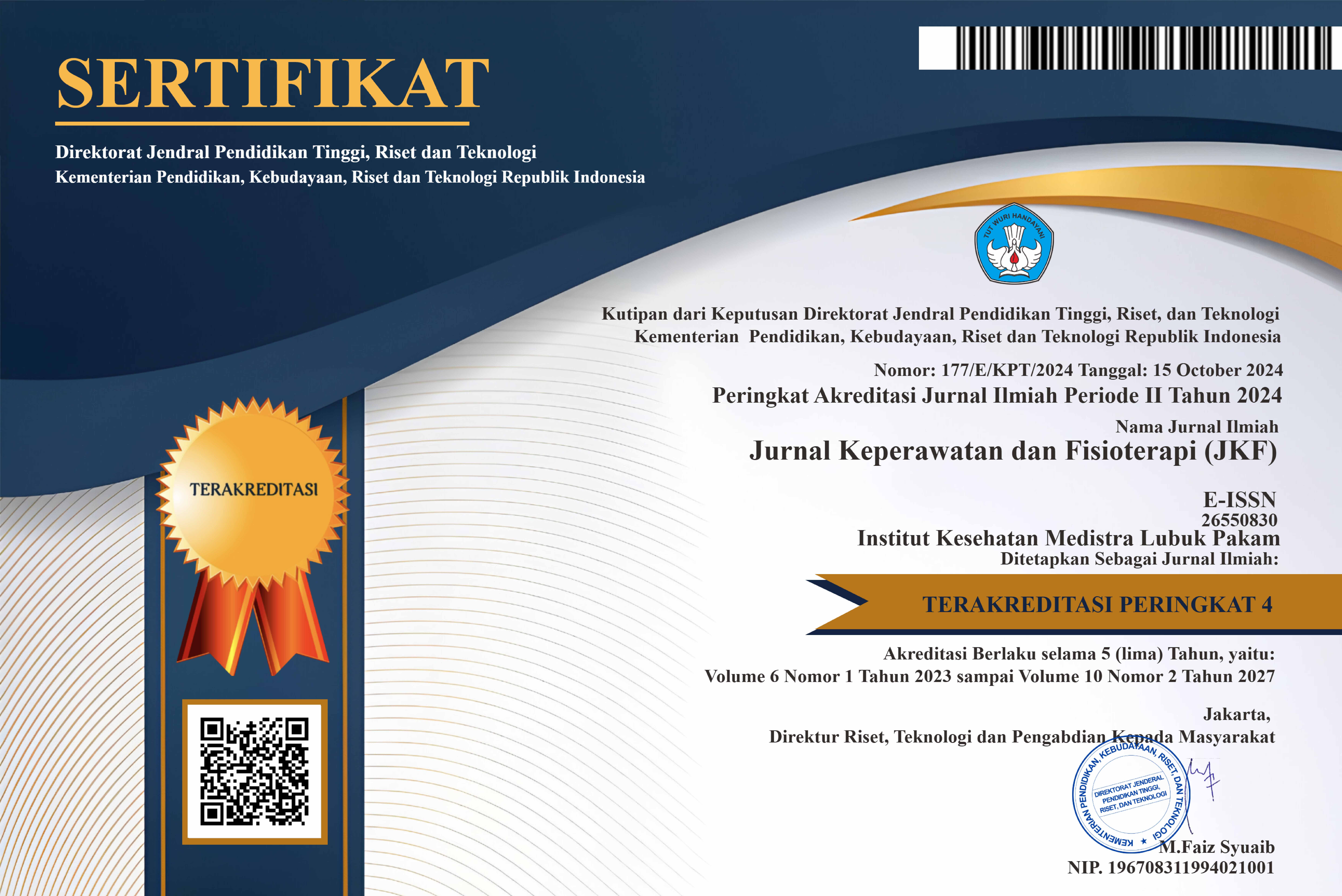A case study Evaluation of the Application of Infection Prevention Bundles in Reducing Infection Risk Factors in Total Thyroidectomy Patients at IBS RSP Hasanuddin University of Makassar
DOI:
https://doi.org/10.35451/jkf.v7i2.2583Keywords:
Infection prevention bundle; Surgical site infection; Total thyroidectomy.Abstract
Background: Surgical area infections (IDOs) are a form of Healthcare Associated Infections (HAIs) that often occur, especially in complex surgical procedures such as total thyroidectomy, which has a high risk of infection due to the long duration of surgery and involvement of vital structures. Prevention of IDO can be done through the implementation of infection prevention bundles, including the administration of prophylactic antibiotics, pre and perioperative antiseptics, as well as blood temperature and glucose control. The purpose of the study is to evaluate the application of infection prevention bundles in reducing the risk of infection in patients undergoing total thyroidectomy with a diagnosis of bilateral thyroid cancer at the Central Surgical Installation of Hasanuddin University Hospital, Makassar. Methods: This study used a descriptive case study design with a single case design method on Mrs. M's patients through three phases: pre-operative, intra-operative, and post-operative. The implementation of the infection prevention bundle includes the administration of prophylactic antibiotics, sterility techniques, blood sugar control, body temperature monitoring, and systematic wound care. Results: The total risk score of perioperative infection was 14 out of 30, indicating a moderate-high risk. However, the implementation of infection prevention bundles has proven to be effective in preventing infection. Evaluation of wound healing using the Southampton Wound Assessment Scale showed that the patient's wound was in a normal healing condition with no signs of infection until the fifth postoperative day. The patient was discharged on the fifth day with good general condition, normal swallowing function, and closed wounds without complications. Conclusions and suggestions: Consistent application infection prevention bundles can lower the risk of surgical area infection, accelerate wound healing, and shorten the duration of hospitalization. This study recommends the management of pre-operative risk factors such as hypertension control and patient education about postoperative wound care for sustainable healing. of This case study examines the application of infection risk factors in total thyroidectomy patients. The risk score for perioperative infection is 14 out of 30, which indicates a moderate-high risk. However the implementation infection prevention bundles has proven to be effective in preventing infection. The administration of prophylactic antibiotics, sterility techniques, blood sugar control, body temperature monitoring, and systematics wound care.
Downloads
References
I. Budiana and K. F. Nggarang, “Penerapan Teknik Aseptik Pada Asuhan Keperawatan Di Ruang Bedah RSUD Kabupaten Ende,” J. Keperawatan Terpadu (Integrated Nurs. Journal), vol. 1, no. 2, p. 56, 2019, doi: 10.32807/jkt.v1i2.38.
Q. adar BakhshBaloch, “PMK RI Nomor 27 Tahun 2017 tentang Pedoman Pencegahan dan Pengendalian Infeksi di Fasilitas Pelayanan Kesehatan,” vol. 11, no. 1, pp. 92–105, 2017.
W. H. Organization, Global guidelines on the prevention of surgical site infection. 2018. [Online]. Available: http://www.who.int/gpsc/ssi-prevention-guidelines/en/#.WB6CWivkT70.mendeley
I. Pudji Wahyuningsih, “Analisis Pelaksanaan Bundles Care Ido terhadap Kejadian Infeksi Daerah Operasi dan Dampaknya terhadap Lama Rawat Pasien,” J. Heal. Sains, vol. 1, no. 6, pp. 366–376, 2020, doi: 10.46799/jhs.v1i6.66.
CDC, “Surgical Site Infection Event (SSI) Introduction,” Natl. Healthc. Saf. Netw., no. January, pp. 1–39, 2022, [Online]. Available: https://www.cdc.gov/nhsn/pdfs/ps-analysis-resources/ImportingProcedureData.pdf.
X. Huang et al., “Risk factors for surgical site infection following pediatric spinal deformity surgery: a systematic review and meta-analysis,” Child’s Nerv. Syst., vol. 13, pp. 2011–2022, 2024, doi: 10.1007/s00381-015-2659-9.
F. A. Salem et al., “A Nested Case–Control Study on the Risk of Surgical Site Infection After Thyroid Surgery,” World J. Surg., vol. 42, no. 8, pp. 2454–2461, 2018, doi: 10.1007/s00268-018-4492-2.
D. M. Elfenbein, D. Schneider, H. Chen, and R. S. Sippel, “Surgical site infection after tyroidectomy: a rare but significant complication,” vol. 190, no. 1, pp. 170–176, 2021, doi: 10.1007/978-981-16-4597-6_15.
M. M. Anwar, A. E. Reizian, A. M. El Kholy, I. El Sayed, and M. K. Hafez, “An assessment scale for patients with postoperative superficial incisional surgical site infection: A cross-sectional study,” Indian J. Surg., vol. 80, no. 3, pp. 259–268, 2018, doi: 10.1007/s12262-016-1566-y.
U. R. I. Febrianti, M. Agustina, M. Merry, S. Suhariyanto, and L. Andriyani, “Penggunaan Transparent Film Dressing Untuk Pencegahan Infeksi Luka Post Operasi Sectio Caesarea Pada Ny. I Di Rsud Dr. Rubini Mempawah,” J. Keperawatan Muhammadiyah Bengkulu, vol. 12, no. 1, pp. 41–48, 2024, doi: 10.36085/jkmb.v12i1.5673.
N. A. Binti Amir, Putu Dwyandaani Priyahita1, and Talitha Syahla1, Eva Triani, “Clinical Diagnosis and Management of Thyroid Cancer,” Unram Med. J., vol. 12, no. 3, pp. 240–246, 2023, doi: 10.29303/jku.v12i3.963.
S. Saeedinia et al., “The incidence and risk factors for surgical site infection after clean spinal operations: A prospective cohort study and review of the literature,” Surg. Neurol. Int., vol. 6, no. 1, 2015, doi: 10.4103/2152-7806.166194.
N. N. Yudianti, “Jurnal Penelitian Perawat Profesional Pencegahan Tetanus,” Br. Med. J., vol. 2, no. 5474, pp. 1333–1336, 2020.
J. Tanner and K. Melen, “Preoperative hair removal to reduce surgical site infection,” Cochrane Database Syst. Rev., vol. 2021, no. 8, pp. 1–113, 2021, doi: 10.1002/14651858.CD004122.pub5.
P. P. Joy, “Perbandingan Cuci Tangan Bedah dengan dan Tanpa Sikat Terhadap Kesterilan Tangan Perawat Bedah di Instalasi Bedah Sentral RSUD Taman Husada Bontang,” J. Cakrawala Ilm., vol. 5, no. August 2006, pp. 228–235, 2016.
B. John, R. K. K, and V. C, “Comparison of efficacy of chlorhexidine alcohol with povidone iodine for prevention of surgical site infection: a prospective study,” Int. Surg. J., vol. 5, no. 5, pp. 1668–1672, 2018.
M. Okamura et al., “Incidence of unintentional intraoperative hypothermia in pediatric scoliosis surgery and associated preoperative risk factors,” Spine Surg. Relat. Res., vol. 5, no. 3, pp. 154–159, 2021, doi: 10.22603/SSRR.2020-0170.
Y. Hu, Y. Tian, M. Zhang, J. Zhao, and Q. Shu, “Study of risk factors for intraoperative hypothermia during pediatric burn surgery,” World J. Pediatr. Surg., vol. 4, no. 1, pp. 1–6, 2021, doi: 10.1136/wjps-2020-000141.
E. T. Rahmanto, D. Novitasari, and W. Sukmawaningtyas, “Hubungan Lama Operasi dengan Hipotermi pada Pasien Pascaspinal Anestesi,” J. Penelit. Perawat Prof., vol. 6, pp. 1449–1458, 2024.
T. Tahir et al., “Topical Cream Derived From Hylocereus polyrhizus (Red Dragon Fruit) Extract Accelerates Wound Healing Through Increased Hydroxyproline and Fibroblast Growth Factor 2 Levels: A Pilot Study,” Plast. aesthetic Nurs., vol. 43, no. 4, pp. 210–216, 2023, doi: 10.1097/PSN.0000000000000526.
Downloads
Published
Issue
Section
License
Copyright (c) 2025 Tendri Mariadjeng Nurpa Masahude, Takdir Tahir, Abdul Majid, Syahrul Ningrat

This work is licensed under a Creative Commons Attribution 4.0 International License.
Copyright in each article is the property of the Author.


























